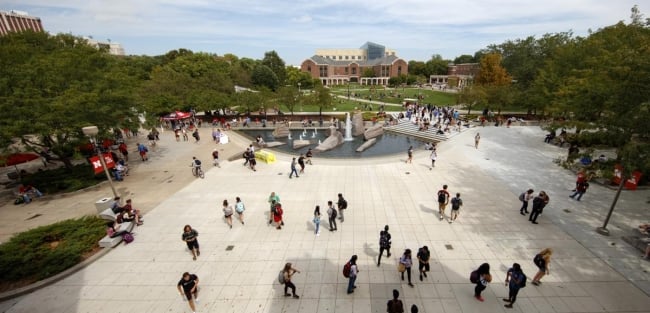You have /5 articles left.
Sign up for a free account or log in.

Students walk through Union Memorial Plaza at the University of Nebraska at Lincoln.
Craig Chandler
The University of Nebraska system has an $800 million problem. That’s the cost of its backlog of capital renewal projects on 900 buildings across the system’s four campuses, which include roof repairs, waterline maintenance and whole buildings in need of renovation or replacement.
It’s a daunting sticker price for a public higher education system, especially in a cash-strapped state like Nebraska. But system officials have partnered with state legislators to come up with an innovative solution, hashing out a deal that would yield more funding and cover 40 years of maintenance costs.
The system took advantage of record-low interest rates during the pandemic to make the first of two planned state bond purchases, each worth $400 million, and successfully sold the first tranche to finance long-delayed repairs and renovations. By 2030, Nebraska plans to purchase another $400 million in bonds for the same purpose. The goal is to use the bond sales to address as much of the capital renewal backlog as possible in the next decade, rather than going to the state every five or 10 years to fund urgent needs.
University of Nebraska system CFO Chris Kabourek said that before the bond sale deal, they were taking a “shotgun approach” to deferred maintenance funding.
“Every 10 years we’d do some projects, but we still had this giant deferred maintenance backlog,” he said. “So we started having conversations about taking a broader, more strategic long-term view to address this.”
The money will fund the construction of modern buildings and facilities, including a state-of-the-art music education center to replace a 70-year-old structure on the Lincoln campus, which Kabourek hopes will attract eyes. But much of the funding will go toward what he calls “unsexy” projects, like rewiring buildings, updating HVAC systems and repairing roofs.
Unsensational as it may seem, this kind of routine upkeep and maintenance can have a big impact on other areas of institutional success, including student satisfaction, enrollment and faculty recruitment.
“We’re all in this talent war not only for students, but for faculty and staff,” Kabourek said. “In a state like Nebraska, we don’t have oceans, we don’t have mountains … sometimes buyers buy with their eyes, and so when students see facilities that are world-class and well maintained, that really helps our recruitment strategy.”
Nebraska’s bond-funding arrangement includes a unique stipulation: for any project funded with state money, the university will take 2 percent of expenditures from the project’s operating budget and add it to a depreciation fund that can be used once the bonds run out.
Kabourek said that for a problem like deferred maintenance costs, which can be difficult to prioritize in budget allocation, this commitment to sustainability could be the most important part of the arrangement, and one that other public universities seeking a better long-term maintenance plan may seek to replicate.
“Deferred maintenance requires budgetary discipline,” Kabourek said. “We’re trying to find a sustainable funding mechanism so that we can wean ourselves off this borrowing mentality.”
It’s a solution that may appeal to state governments, too. Kabourek said the arrangement is likely to save taxpayers about $1.5 billion over 40 years by allowing the university to pay for a large chunk of its backlog up front. And the built-in depreciation fund will ensure that the university can meet future needs on its own, so the state doesn’t have to worry about shelling out more money for deferred maintenance after the deal runs out.
Nebraska state senator John Stinner, who was the university’s main legislative partner in the bond sale plan, compared the fund to the allegory of teaching a man to fish instead of giving him a meal.
“I would not have supported it if not for [the depreciation fund],” Stinner said. “I wanted to solve a problem over a long period of time and not have them continually come back to the Legislature for additional dollars.”
A National Backlog
The University of Nebraska is far from alone in its deferred maintenance problem. According to APPA, an association of physical plant administrators that serves as a national resource for educational facilities, the cost of the national backlog for capital renewal projects is over $2 trillion.
“The average age of [higher education] buildings is 50 years old,” said APPA president Lander Medlin. “That’s pretty much their life cycle. So a lot of this is coming due, whether institutions like it or not.”
Delaying capital renewal work—or “facilities optimization,” as Medlin calls it—can lead to more expensive issues down the line.
“If you don’t do this preventative maintenance work, it really does cause the life of that system or building to decay faster,” she said. “It’s a domino effect. And that’s what we’re all trying to avoid, but facilities professionals only have so much money.”
A major factor in the sheer size of deferred maintenance backlogs has been a historical decrease in facilities funding. According to a study by EAB, an education consulting firm, between 2008 and 2013, spending in every category at public institutions rose—except for operations and maintenance. In fact, spending in that category decreased by 8 percent per student from 1987 to 2013.
 Medlin said this drop in maintenance spending is especially concerning given the rate at which colleges and universities have grown during the same period.
Medlin said this drop in maintenance spending is especially concerning given the rate at which colleges and universities have grown during the same period.
“It is the nature of the facilities infrastructure beast that, over time, it is going to decay,” Medlin said. “We have not been able to keep up with that decay. But at the same time, we’ve been building more and more.”
“We have to be honest and transparent about what we have to support and what we can support,” she added. “And I think we’ve just really lost our way in that regard.”
Donors rarely provide for capital renewal in gifts to fund new buildings, Medlin said, which is part of the reason universities are able to build more than they can often maintain.
“You get all these gifts to fund the planning, design and construction of new buildings, but they don’t require funding the periodic recurring costs of capital renewal,” Medlin said. “Nobody wants to be in a ribbon-cutting ceremony for a new roof or a new steam line.”
Prioritizing Maintenance
One deferred maintenance success story is that of the University of Virginia, which decreased its capital renewal backlog from a high of $196 million in 2009 to $134 million in 2016. Founded in 1819, the Charlottesville campus has more than 550 buildings, 70 percent of which are more than 30 years old; some facades and interiors date back more than a century.
Mark Webb, programs and informatics director for UVA Facilities, has worked in the university’s facilities management division since 1993. When he first started, he said, there was a lot of work to be done on deferred maintenance projects—namely roof repairs.
“Whenever there was a heavy rainstorm, the bucket brigades would go out and say, ‘OK, put buckets in all the usual locations,’” he said. “That literally happened … and roofs accelerated the decay in so many other areas.”
Webb said the tide turned in 2006, when administrators appealed to the Board of Visitors, the body responsible for long-term planning at UVA, and convinced them to fund a substantial budget for capital renewal projects.
The key, said Webb, was knowing which projects to prioritize.
“It’s rare that you’re going to have the magnitude of dollars or the space resources to address your backlog in a holistic way,” he said. “Gradually funding it and improving a building or two at a time is the right way to go about it. That way you keep operations running and keep the financial amount in reason.”
But for most public universities that struggle to get enough state funding, prioritizing deferred maintenance costs can be a hard sell to lawmakers.
In West Virginia, public institutions have hundreds of millions of dollars in capital renewal needs. Last month, Sarah Armstrong Tucker, chancellor of both the West Virginia Higher Education Policy Commission and the state’s community and technical college system, asked the state Legislature for over $350 million to address them. She told West Virginia Public Broadcasting that the last time a deferred maintenance funding request was granted was in 2013.
Medlin said examples like West Virginia are common, and they point to the need for innovative funding solutions—like the one devised by the Nebraska system.
“I think that is really a feasible solution,” she said. “Community colleges have used local bond referendums forever to build out their facilities … I don’t see any reason why that isn’t a good deal” for public institutions.





